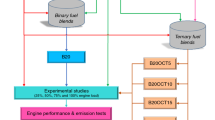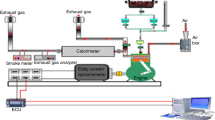Abstract
In this investigation, blends of Mesua ferrea methyl esters (FAME) and ethyl esters (FAEE) with petroleum diesel were used for complete thermal analysis (heat balance) in a computerized compression ignition engine at variable load and at different compression ratios (CR 15 and CR 18). In addition to heat balance, performance parameters like brake thermal efficiency and brake-specific fuel consumption of the CI engine fueled with biodiesel and blends were also investigated. The emissions analysis viz. CO, CO2, HC, NOx, and O2 were measured using an AVL DiGas 444 analyzer. It was observed that the work done was increasing with the increase in load and to some extent with the increase in CR and blending ratio. At CR 18, FAEE-B10 showed the maximum 29.3 % useful work, while diesel showed only 26.3 % at full load condition. At highest load and CR 18, HC, NOx, and CO2 emissions were found to be lesser than that from the petroleum diesel, and among all the blends, FAEE-B10 was found as a better substitute for diesel engine.








Similar content being viewed by others
Abbreviations
- BP:
-
Brake power
- BSFC:
-
Brake-specific fuel consumption
- BTHE:
-
Brake thermal efficiency
- CO2 :
-
Carbon dioxide
- CO:
-
Carbon monoxide
- CR:
-
Compression ratio
- EE-B10:
-
Ethyl ester B10 blend
- EE-B20:
-
Ethyl ester B20 blend
- FAEE:
-
Fatty acid ethyl ester
- FAME:
-
Fatty acid methyl ester
- GHG:
-
Green house gas
- HC:
-
Hydrocarbon
- ME-B10:
-
Methyl ester B10 blend
- ME-B20:
-
Methyl ester B20 blend
- VCR:
-
Variable compression ratio
- CV:
-
Calorific value (MJ kg−1)
- \( C_{\text{Pg}} \) :
-
Specific heat of gas (kJ kg−1 K−1)
- \( C_{\text{PW}} \) :
-
Specific heat of water (kJ kg−1 K−1)
- m a :
-
Air flow rate (kg h−1)
- m f :
-
Fuel flow rate (kg h−1)
- m w :
-
Engine water flow (kg h−1)
- T 1 :
-
Engine water inlet temperature (K)
- T 2 :
-
Engine water outlet temperature (K)
- T 3 :
-
Exhaust gas to calorimeter inlet temperature (K)
- T 4 :
-
Exhaust gas to calorimeter outlet temperature (K)
References
Glaser JA. Green chemistry metrics. Clean Technol Environ Policy. 2009;11(4):371–4.
Karthikeyan R, Mahalakshmi NV. Performance and emission characteristics of a turpentine diesel duel fuel engine. Energy. 2005;32:1202–9.
Reports and Publications. Statistical review of world energy. June 2007.
Jaber J, Badran O, Abu-Shikhah N. Sustainable energy and environmental impact: role of renewables as clean and secure source of energy for the 21st century in Jordan. Clean Technol Environ Policy. 2004;6(3):174–86.
Freire MM, Bicuto TC, Rosenhaim R, Sinfronio FSM, Botelho JR, Carvalho JR, Santos IMG, Antoniosi NR, Souza AG. Thermal investigation of oil and biodiesel from Jatropha curcas L. J Therm Anal Calorim. 2009;96:1029–33.
Tutunea D. Thermal investigation of biodiesel blends derived from rapeseed oil. J Therm Anal Calorim. 2013;111:869–75.
Todaka M, Kowhakul W, Masamoto H, Shigematsu M, Onwona-Agyeman S. Thermal decomposition of biodiesel fuels produced from rapeseed, jatropha, and coffee oils with different alcohols. J Therm Anal Calorim. 2013;113:1355–61.
Zhang Q, Saleh ASM, Chen J, Sun P, Shen Q. Monitoring of thermal behavior and decomposition products of soybean oil. An application of synchronous thermal analyzer coupled with Fourier transform infrared spectrometry and quadrupole mass spectrometry. J Therm Anal Calorim. 2014;115:19–29.
Rodríguez R, Sierens R, Verhelst S. Thermal and kinetic evaluation of biodiesel derived from soybean oil and higuereta oil. J Therm Anal Calorim. 2009;96(3):897–901.
Halek F, Delavari A, Kavousi-rahim A. Production of biodiesel as a renewable energy source from castor oil. Clean Technol Environ Policy. 2013. doi:10.1007/s10098-012-0570-6.
Conceicao MM, Dantas MB, Rosenhaim R, Fernandes VJ, Santos IMG, Souza AG. Evaluation of the oxidative induction time of the ethilic castor biodiesel. J Therm Anal Calorim. 2009;97:643–6.
Kiakalaieh AT, Amin NAS, Mazaheri H. A review on novel processes of biodiesel production from waste cooking oil. Appl Energy. 2013;104:683–710.
Biona JBM, Licauco J. Performance, smoke characteristics and economics of pre-heated used vegetable oil utilization in Philippine public utility jeepneys. Clean Technol Environ Policy. 2009. doi:10.1007/s10098-008-0195-y.
Hazar H, Aydin H. Performance and emission evaluation of a CI engine fuelled with preheated raw rapeseed oil (RRO)-diesel blends. Appl Energy. 2010;87:786–90.
Hebbal OD, Vijayakumar Reddy K, Rajagopal K. Performance characteristics of a diesel engine with deccan hemp oil. Fuel. 2006;85:2187–94.
Zhu L, Cheing CS, Zhang WG, Huang Z. Combustion, performance and emission characteristics of a DI diesel engine fueled with ethanol–biodiesel blends. Fuel. 2011;90:1743–50.
Tsolakis A, Megaritis A, Yap D. Engine performance and emissions of a diesel engine operating on diesel-RME (rapeseed methyl ester) blends with EGR (exhaust gas recirculation). Energy. 2008;33:462–70.
Resitoglu IA, Altinisik K, Keskin A. The pollutant emissions from diesel-engine vehicles and exhaust after treatment systems. Clean Technol Environ Policy. 2015. doi:10.1007/s10098-014-0793-9.
Raheman H, Ghadge SV. Performance of diesel engine with biodiesel at varying compression ratio and ignition timings. Fuel. 2008;87:2659–66.
Pielecha I, Borowski P, Czajka J, Wislocki K, Kazmierowski J. Combustion process shaping by use of different strategies of multiple fuel injection in a CI model engine. J Therm Anal Calorim. 2015;119:695–703.
Sun J, Caton JA, Jacobs TJ. Oxides of nitrogen emissions from biodiesel-fueled diesel engines. Prog Energy Comb Sci. 2010. doi:10.1016/j.pecs.2010.02.004.
Baiju B, Nail MK, Das LM. A comparative evaluation of compression ignition engine characteristics using methyl and ethyl esters of Karanja oil. Renew Energy. 2009;34:1616–21.
Satyanarayana M, Muraleedharan C. A comparative study of vegetable oil methyl esters (biodiesels). Energy. 2011;36:2129–37.
Sarma AK, Aslam M, Saxena P. Green technology for biodiesel production from MesuaFerrea L. seed oil. Energy Environ Res. 2014. doi:10.5539/eer.v4n2p11.
Aslam M, Kothiyal NC, Sarma AK. True boiling point distillation and product quality assessment of biocrude obtained from Mesuaferrea L. seed oil. Clean Technol Environ Policy. 2014. doi:10.1007/s10098-014-0774-z.
Sarma AK. Biodiesel production from Mesua ferrea L and Pongamia glabra Vent. Lap Lambert Academic Pub. 2015. ISBN 9783659438646.
Sakthivel G, Snehitkumar B, Hangkumaran M. Application of fuzzy logic in internal combustion engines to predict the engine performance. Int J Ambient Energy. 2014. doi:10.1080/01430750.952844.
Nagaraja S, Sakthivel M, Sudhakaran R. Combustion and performance analysis of variable compression ratio engine fueled with preheated palm oil-diesel blends. Ind J Chem Technol. 2013;20:189–94.
Acknowledgements
The first author acknowledges with thanks for the platform provided for the experimental work at SSS-NIRE and fellowship granted by MHRD for research works. The authors acknowledge the Ministry of New and Renewable Energy, Government of India, for financial assistance in the form of project grants (FNo. 7/144/2009-NT dt.01.10.2010 & 7/152/2010-BF date 13/09/2011).
Author information
Authors and Affiliations
Corresponding author
Electronic supplementary material
Below is the link to the electronic supplementary material.
Rights and permissions
About this article
Cite this article
Singh, N., Kumar, H., Jha, M.K. et al. Complete heat balance, performance, and emission evaluation of a CI engine fueled with Mesua ferrea methyl and ethyl ester’s blends with petrodiesel. J Therm Anal Calorim 122, 907–916 (2015). https://doi.org/10.1007/s10973-015-4777-8
Received:
Accepted:
Published:
Issue Date:
DOI: https://doi.org/10.1007/s10973-015-4777-8




